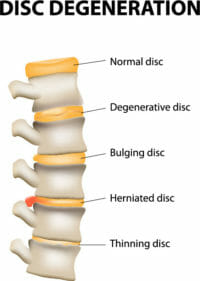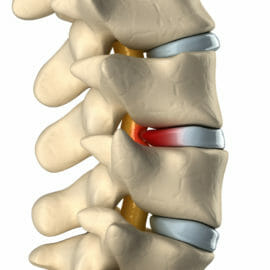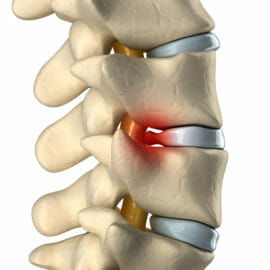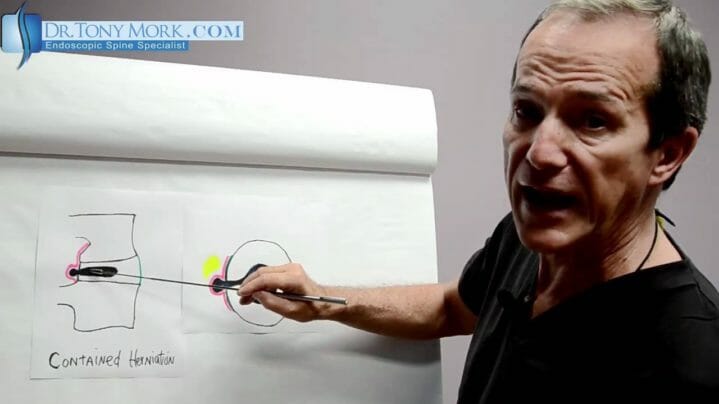
You may have had a medical exam that revealed an underlying health problem. The physician explained that you have a Bulging Disc, but you may still have questions that have been unanswered.
This condition can happen to anyone at any age but is more prevalent in older populations or with those who are involved in strenuous physical activity for extended periods of time. It is important to understand the symptoms, causes, and treatments for a bulging disc to prevent the condition from worsening.
What Is a Bulging Disc?
Your spine consists of vertebrae which have spinal discs in between to act as a shock absorber, preventing damage to the spinal tissue and bone.
They also help to make movement easier. Discs have a hard casing and liquid-like center. Movement or slipping of the disc from its normal positioning results in an outward swelling of the fluid material throughout the weakest point of the shell of the disc. In many cases, the disc balloons in between spaces in the vertebrae. This process happens over an extended period. The longer that a condition progresses, the worse the symptoms will become. Bulging discs may refer to a protruding disc.
Symptoms
If a bulging disc has not yet reached the stage of herniation, a patient may have little to no pain involved. A bulging disc may have no pain at all because it has not reached a certain severity level, and this can make it difficult to identify the bulging disc symptoms before the condition becomes more severe.
Most commonly, bulging discs create pressure points on nearby nerves which create a variety of sensations. Evidence of a bulging disc may range from mild tingling and numbness to moderate or severe pain, depending on the severity. In most cases, when a bulging disc has reached this stage it is near or at herniation.
- Tingling or pain in the fingers, hands, arms, neck or shoulders. This could indicate a bulging disc in the cervical area.
- Pain in the feet, thighs, lower spine and buttocks. This is the most common symptom and could indicate an issue in the lumbar region.
- Difficulty walking or feeling of impairment while lifting or holding things.
These symptoms require immediate medical evaluation as they may be a sign of a potentially life-threatening condition.
When the sciatic nerve is affected, the sensations are present down one leg or the other, but usually not both. Bladder incontinence can occur because of a bulging disc compressing the nerves that control the bladder. In this case, seek emergency medical help immediately. Upper back pain radiating to the stomach or chest may be a symptom of a mid-spine bulging disc. Muscle spasms may also occur with any bulging disc. While some patients may go on for years without disturbing symptoms, others may experience extreme or life threatening consequences.
Causes
You, the client, may be the best resource for determining the cause of bulging disc. Your physician will ask a series of questions about your lifestyle and the type of physical activity you’ve performed throughout your life.
The most common cause of the condition may be due to the natural aging process and disc degeneration combined with other risk factors. Discs may become more vulnerable over time.
Potential Causes for a Bulging Disc
- People who have led a sedentary lifestyle or those who smoke increase the chances for bulging disc.
- Continuous strain on the disc from injury or heavy lifting and strain can wear them down throughout the years.
- Weakened back muscles can accelerate the process and may lead to a sudden herniation of the weakened disc.
- Although bulging discs occur over time, herniated discs may occur quickly by trauma.
- Bad posture including improper body positioning during sleep, sitting, standing or exercise are all risk factors which may contribute to the development of a bulging disc.
- Obesity
- High contact sports or activities are also risk factors.
- Runners who fail to use shoes that provide orthopedic support may also develop bulging discs.
- Activities that place stress and strain on the spine can lead to the weakening of the discs.
Diagnosis
A thorough medical examination including X-ray and in some cases, CT or MRI scans are necessary to diagnose bulging disc conditions to the full extent accurately. These testing formats show changes in shape and condition of the disc.
Bulging Disc vs. Herniated Disc


A disc bulge is not a disc herniation. This distinction is made by David F. Fardon, MD, and Pierre C. Milette, MD in their Combined Task Forces of the North American Spine Society. (https://www.spine.org/Portals/0/Assets/Downloads/ResearchClinicalCare/Nomenclature.pdf)
In simple terms, a disc bulge refers to an apparent generalized extension of disc tissues beyond the edges of the edge of vertebrae, usually less than 3mm. Bulge is a term for an image and can be a normal variant (usually at L5-S1). It can result from advanced disc degeneration or from vertebral body remodeling (as consequent to osteoporosis, trauma, or adjacent structural deformity). It can also occur with ligamentous laxity in response to loading. The one interesting aspect about a “bulge” is that it is an MRI finding that can correlate with an annular tear that causes deep midline low back pain. The annular tear can be confirmed with a discogram followed with a CT scan.
The discussion about a disc herniation is much more comprehensive and complicated since there are so many ways and places that a disc can herniate.
Bulging Disc Treatment
Before considering a bulging disc treatment or herniated disc surgery there are a few things you should try to get under wraps before you consider any treatment, minimally invasive or not.
A patient should change body positioning and behaviors (sleeping, sitting and posture positions) first to help reduce any bulging disc symptoms or pain caused by the affected disc. Addressing causal factors may help to slow the worsening of the condition.
- A healthy weight reduction plan and exercise can be used to help obese patients.
- In some cases, a doctor may recommend physical therapy to strengthen muscles in the back and to regain any lost mobility.
Before herniation, many of the non-surgical treatments are successful in managing bulging discs. Pain management options depend on the severity. Mild to moderate discomfort can be relieved with anti-inflammatory medications both over the counter and prescription.
It is also recommended to use heating pads, ice packs, massage therapy, and exercise to reduce pain symptoms. Some physicians may recommend taping or bracing to support the affected area for a length of time. In emergency cases when the disc is causing life-threatening consequences, a surgeon can perform surgery, but this is rare.
New Treatment Options
Minimally Invasive treatments are becoming more common and endoscopic spine surgery might be an option in relieving the pain. Surgeons can utilize minor surgical techniques in order to correct bulging disc problems.
Post procedure, patients may be advised to perform exercises which strengthen back muscles. The type of procedure which a surgeon performs through the minimally invasive platform depends upon the extent of the problem and the kind of issues that the bulging disc are causing.
Final Thoughts
A bulging disc is a medical condition that develops over long periods of time. Although seen more often with aging, it can happen to younger people as well. There are few if any symptoms and early identification is only possible through medical testing and scans that show changes in disc shape and positioning. Some may experience sensations ranging from tingling to various levels of pain before advanced disc bulging and herniation. Early detection means that simpler treatments may prevent worsening of the condition. If you have any questions, do not hesitate to contact us to speak with one of our specialists.
